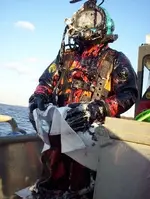is the bowsprit intact ? if so look at how the gammoning attaches the keel to the bowsprit, if it has a saddle cut into the bowsprit it is from the 1700's, if there is a tennon with a board in front to keep the gammoning ropes from sliding it is early 1800's, if just the tennon then it is mid to late 1800's. the cannons should have some sort of markings on them that can help date the ship. the british built their ships different from us, the keel and keelson were notched to hold the ribs and they used tennons between the ribs on the planking edge to help absorb cannon fire, the keel should be made from elm if it is british, the british used a tool to keep the spikes from splitting while being hammered the head ends of the spikes should be in good condition. if it is an armed british ship that can help date the wreck. if it is American made we used more ribs but they were slightly smaller, the spikes will probably have splits on the heads(cracking) from being hit directly, we used iron for the lightning protection the british used copper, theirs will be plates nailed into the keel/keelson area by the mast step, ours were iron rods. if any china is on board that can help date the wreck. crock work too can help date the wreck, the type of cannon balls or ordinance can help date the wreck. glassware can help too. let us know what you see and maybe we can help.





